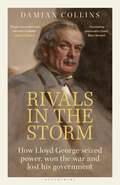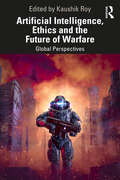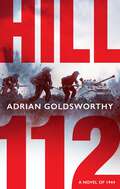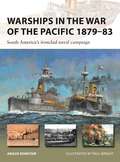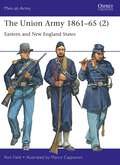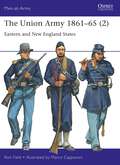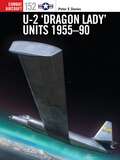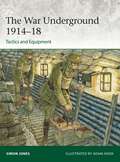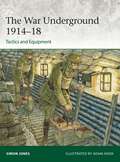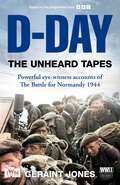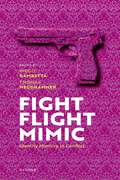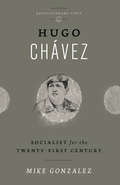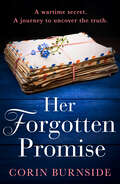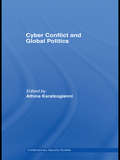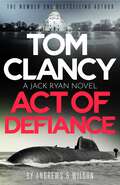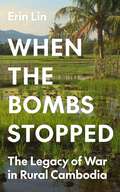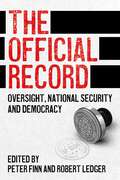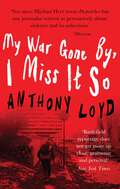- Table View
- List View
Rivals in the Storm: How Lloyd George seized power, won the war and lost his government
by Damian CollinsA vivid biography in cinematic snapshots of David Lloyd George, one of the world's greatest statesmen.Brought up in rural North Wales, David Lloyd George attended neither a grand school nor ancient university. He was very much an outsider. And yet he rose through the ranks with charisma, fierce intelligence and fighting spirit to become, as Churchill put it in his tribute, a man who 'stood, when at his zenith, without a rival'.But his rise was not without its hardships, and in Rivals in the Storm, experienced MP and author Damian Collins focuses on the impact of Lloyd George's personality on other leading politicians, in driving progressive reforms through government, changing the course of the First World War to lead the Allies to victory, and cementing Britain's alliance with America.Covering Lloyd George's emergence as the dominating political personality in Great Britain to the aftermath of his resignation, this fascinating biography takes you inside the rooms where the important decisions happened, and shows the bitter struggles as well as the triumphs of this great man of his or any other age, who nonetheless fell short of his own high expectations.
Rivals in the Storm: How Lloyd George seized power, won the war and lost his government
by Damian CollinsA vivid biography in cinematic snapshots of David Lloyd George, one of the world's greatest statesmen.Brought up in rural North Wales, David Lloyd George attended neither a grand school nor ancient university. He was very much an outsider. And yet he rose through the ranks with charisma, fierce intelligence and fighting spirit to become, as Churchill put it in his tribute, a man who 'stood, when at his zenith, without a rival'.But his rise was not without its hardships, and in Rivals in the Storm, experienced MP and author Damian Collins focuses on the impact of Lloyd George's personality on other leading politicians, in driving progressive reforms through government, changing the course of the First World War to lead the Allies to victory, and cementing Britain's alliance with America.Covering Lloyd George's emergence as the dominating political personality in Great Britain to the aftermath of his resignation, this fascinating biography takes you inside the rooms where the important decisions happened, and shows the bitter struggles as well as the triumphs of this great man of his or any other age, who nonetheless fell short of his own high expectations.
Artificial Intelligence, Ethics and the Future of Warfare: Global Perspectives
by Kaushik RoyThis volume examines how the adoption of AI technologies is likely to impact strategic and operational planning, and the possible future tactical scenarios for conventional, unconventional, cyber, space and nuclear force structures. In addition to developments in the USA, Britain, Russia and China, the volume also explores how different Asian and European countries are actively integrating AI into their military readiness. It studies the effect of AI and related technologies in training regimens and command structures. The book also covers the ethical and legal aspects of AI augmented warfare.The volume will be of great interest to scholars, students and researchers of military and strategic studies, defence studies, artificial intelligence and ethics.
Artificial Intelligence, Ethics and the Future of Warfare: Global Perspectives
by Kaushik RoyThis volume examines how the adoption of AI technologies is likely to impact strategic and operational planning, and the possible future tactical scenarios for conventional, unconventional, cyber, space and nuclear force structures. In addition to developments in the USA, Britain, Russia and China, the volume also explores how different Asian and European countries are actively integrating AI into their military readiness. It studies the effect of AI and related technologies in training regimens and command structures. The book also covers the ethical and legal aspects of AI augmented warfare.The volume will be of great interest to scholars, students and researchers of military and strategic studies, defence studies, artificial intelligence and ethics.
Hill 112: a novel of D-Day and the Battle of Normandy
by Adrian GoldsworthyA gripping story of friendship and division in the midst of warfare, set against one of the most dramatic, dangerous, and crucial campaigns of World War II: the Battle of Normandy. They went to war as boys. Will they make it home as men?D-Day. June 6th, 1944. The trajectory of the Second World War – and with it the course of modern history – is changed for ever.For three young former schoolmates from South Wales, their war is only just beginning.James was the school cricket captain. Now, a few short years later, he is in charge of a troop of Sherman tanks.Mark, just nineteen, must lead a platoon of infantrymen into battle.And Bill, always something of a loner, sees the heart of the fighting as a private soldier.These young men, and thousands of others, will soon be a part of one of the bloodiest and most brutal parts of the Normandy campaign: the battle for Hill 112. The horror, the fear, the filth; the savage fighting; the sheer exhilaration and moments of farce and laughter: those who come through the carnage will never be the same again.From critically acclaimed author and historian Adrian Goldsworthy, Hill 112 is based on real events and the records and reminiscences of those who were there. Published to coincide with the eightieth anniversary of D-Day, Hill 112 is perfect for fans of Robert Harris and Simon Scarrow.
Warships in the War of the Pacific 1879–83: South America's ironclad naval campaign (New Vanguard #328)
by Angus KonstamSuperbly illustrated with original artwork throughout, this book explores the ironclad warships that fought the little-known battles of South America's War of the Pacific. In the late 19th century, a war erupted between Chile and Peru, the catalyst for which was control of guano-rich Chincha islands. Given the geography of the two countries, with a narrow, arid land border and long exposed coastlines, it was inevitable that the War of the Pacific would predominantly be a naval war. It was a unique episode of military history, fought by two newly emergent South American states, using the latest technology – ironclad, steam-powered warships – and involving more naval battles than in the American Civil War, including a blockade, the capture of key warships, and bombardments of ports. Chile's navy was larger and more modern, while Peru's trump card was the small but powerful ironclad Huáscar. In this book, naval expert Angus Konstam offers readers an essential guide to this little-known naval war, illustrated with detailed profiles of the key ironclads, spectacular original artwork of the battles and a cutaway of Huáscar. He briefly covers the strategies of the warring powers as well as exploring all the key points of the naval campaign and the details of the warships involved, as a handful of ironclads fought for naval supremacy in South America.
Warships in the War of the Pacific 1879–83: South America's ironclad naval campaign (New Vanguard #328)
by Angus KonstamSuperbly illustrated with original artwork throughout, this book explores the ironclad warships that fought the little-known battles of South America's War of the Pacific. In the late 19th century, a war erupted between Chile and Peru, the catalyst for which was control of guano-rich Chincha islands. Given the geography of the two countries, with a narrow, arid land border and long exposed coastlines, it was inevitable that the War of the Pacific would predominantly be a naval war. It was a unique episode of military history, fought by two newly emergent South American states, using the latest technology – ironclad, steam-powered warships – and involving more naval battles than in the American Civil War, including a blockade, the capture of key warships, and bombardments of ports. Chile's navy was larger and more modern, while Peru's trump card was the small but powerful ironclad Huáscar. In this book, naval expert Angus Konstam offers readers an essential guide to this little-known naval war, illustrated with detailed profiles of the key ironclads, spectacular original artwork of the battles and a cutaway of Huáscar. He briefly covers the strategies of the warring powers as well as exploring all the key points of the naval campaign and the details of the warships involved, as a handful of ironclads fought for naval supremacy in South America.
The Union Army 1861–65: Eastern and New England States (Men-at-Arms #555)
by Ron FieldThis book describes and illustrates the uniforms and personal equipment of the troops fielded by the Eastern and New England states that fought for the Union during the American Civil War. During 1861–65, the United States Army, pitted against the forces of the fledgling Confederacy, fought to defend the Union during five long years of bitter conflict. This volume, the second in a three-part study, chronicles the clothing, insignia and gear worn by the soldiers fielded by 12 of the states that fought to preserve the Union. While uniforms conforming to standard Union Army patterns were widely issued to these troops, some wore distinctive items of dress or insignia, and a wide variety of weapons were carried. Ron Field, an acknowledged authority on US military apparel, reveals how the Eastern and New England states clothed and equipped their regiments during the Civil War. Eight plates of original artwork showing officers and enlisted men of the Union Army are complemented by photographs of soldiers and items of uniform from a variety of sources.
The Union Army 1861–65: Eastern and New England States (Men-at-Arms #555)
by Ron FieldThis book describes and illustrates the uniforms and personal equipment of the troops fielded by the Eastern and New England states that fought for the Union during the American Civil War. During 1861–65, the United States Army, pitted against the forces of the fledgling Confederacy, fought to defend the Union during five long years of bitter conflict. This volume, the second in a three-part study, chronicles the clothing, insignia and gear worn by the soldiers fielded by 12 of the states that fought to preserve the Union. While uniforms conforming to standard Union Army patterns were widely issued to these troops, some wore distinctive items of dress or insignia, and a wide variety of weapons were carried. Ron Field, an acknowledged authority on US military apparel, reveals how the Eastern and New England states clothed and equipped their regiments during the Civil War. Eight plates of original artwork showing officers and enlisted men of the Union Army are complemented by photographs of soldiers and items of uniform from a variety of sources.
U-2 ‘Dragon Lady’ Units 1955–90 (Combat Aircraft #152)
by Peter E. DaviesAn illustrated account of the early service of the Lockheed U-2, one of the most important and longest-serving intelligence gathering platforms fielded by the US air force.The U-2 is one of the most recognizable aircraft of the Cold War; nicknamed the 'Dragon Lady' after the codename given to it by the CIA, this powered glider was designed and operated in great secrecy, providing US authorities with photographic and electronic information from areas of interest across the globe. This illuminating new volume dives deep into the U-2's most critical missions, exploring its role in the Cuban Missile Crisis, nuclear reconnaissance in the Soviet Union, and intelligence missions in China and North Vietnam.Using previously unpublished research, aviation expert Peter E. Davies examines the operations of one of the landmark aircraft of the 20th century from a fresh and engaging perspective, enhanced by more than 50 photos and 21 newly commissioned profile artworks.
U-2 ‘Dragon Lady’ Units 1955–90 (Combat Aircraft #152)
by Peter E. DaviesAn illustrated account of the early service of the Lockheed U-2, one of the most important and longest-serving intelligence gathering platforms fielded by the US air force.The U-2 is one of the most recognizable aircraft of the Cold War; nicknamed the 'Dragon Lady' after the codename given to it by the CIA, this powered glider was designed and operated in great secrecy, providing US authorities with photographic and electronic information from areas of interest across the globe. This illuminating new volume dives deep into the U-2's most critical missions, exploring its role in the Cuban Missile Crisis, nuclear reconnaissance in the Soviet Union, and intelligence missions in China and North Vietnam.Using previously unpublished research, aviation expert Peter E. Davies examines the operations of one of the landmark aircraft of the 20th century from a fresh and engaging perspective, enhanced by more than 50 photos and 21 newly commissioned profile artworks.
The War Underground 1914–18: Tactics and Equipment (Elite #256)
by Simon JonesThis absorbing illustrated study reveals the evolving tactics and techniques used by all sides in the underground war during 1914–18. Covering the Western Front but also the Gallipoli and Italian theatres, this study explores three aspects of World War I below ground: military mining, attack tunnels and dugouts. In 1914–17, the underground war was a product of static trench warfare, essential to survive it and part of both sides' attempts to overcome it. In 1917–18 it was rendered largely obsolete by the development of the all-arms battle as mobility was restored to the battlefield. In the stagnant, troglodyte existence of trench warfare, military mining was a hidden world of heroism and terror in which hours of suspenseful listening were spent monitoring the steady picking of unseen opponents, edging quietly towards the enemy, and judging when to fire a charge. Break-ins to enemy mine galleries resulted in hand-to-hand fighting in the darkness. The ingenuity, claustrophobia and tactical importance of the underground war are discussed and depicted in this fully illustrated study from an acknowledged expert. The artwork plates include depictions of the specialized uniforms, weapons and equipment used underground, as well as vignettes that vividly convey the many aspects of subterranean warfare during World War I.
The War Underground 1914–18: Tactics and Equipment (Elite #256)
by Simon JonesThis absorbing illustrated study reveals the evolving tactics and techniques used by all sides in the underground war during 1914–18. Covering the Western Front but also the Gallipoli and Italian theatres, this study explores three aspects of World War I below ground: military mining, attack tunnels and dugouts. In 1914–17, the underground war was a product of static trench warfare, essential to survive it and part of both sides' attempts to overcome it. In 1917–18 it was rendered largely obsolete by the development of the all-arms battle as mobility was restored to the battlefield. In the stagnant, troglodyte existence of trench warfare, military mining was a hidden world of heroism and terror in which hours of suspenseful listening were spent monitoring the steady picking of unseen opponents, edging quietly towards the enemy, and judging when to fire a charge. Break-ins to enemy mine galleries resulted in hand-to-hand fighting in the darkness. The ingenuity, claustrophobia and tactical importance of the underground war are discussed and depicted in this fully illustrated study from an acknowledged expert. The artwork plates include depictions of the specialized uniforms, weapons and equipment used underground, as well as vignettes that vividly convey the many aspects of subterranean warfare during World War I.
D-Day: Powerful Eye-witness Accounts of The Battle for Normandy 1944
by Geraint JonesA powerful, immersive account published for the 80th anniversary of the D-Day landings and battle for Normandy, accompanying a groundbreaking BBC2 documentary series D-Day: The Unheard Tapes.D-Day was a critical turning point in the Second World War, and a master stroke in planning and logistics, but for the tens of thousands of young men who took part in the amphibious assault, D-Day was bloody, chaotic, and frequently terrifying. For those who survived the beaches, months of bitter fighting lay ahead, often against some of Germany's most elite and fanatical divisions.Using audio interviews from the archives of the Imperial War Museums and National World War II Museum, this immersive oral history describes what it was actually like to take part in the landings on 6 June 1944 and the weeks of ferocious fighting in Normandy that followed. British, American, Canadian and German veterans, as well as French civilians, speak of experiences they could never forget.Stories include the forward observer hiding alone on Omaha beach, thinking of his wife as he waits for the invasion to begin. The commando racing to the besieged airborne forces at Pegasus Bridge. The Typhoon pilot about to be executed by the SS when he is saved by a Luftwaffe officer. The teenage GI surrounded and under fire for six days. The German soldier haunted by the memory of abandoning his dying friend.In D-Day The Unheard Tapes Geraint Jones has skilfully brought the battle for Normandy to life in a vivid narrative that allows the voices of those who fought to shine through, authentic and unforgettable.
Fight, Flight, Mimic: Identity Mimicry in Conflict
FIight, Flight, Mimic is the first systematic study of deceptive mimicry in the context of wars. Deceptive mimicry -- the manipulation of individual or group identity -- includes passing off as a different individual, as a member of a group to which one does not belong, or, for a group, to 'sign' its action as another group. Mimicry exploits the reputation of the model it mimics to avoid capture (flight), to strike undetected at the enemy (fight), or to hide behind or besmirch the reputation of the model group ('false flag' operations). These tactics have previously been described anecdotally, mixed in with other ruses de guerre, but the authors show that mimicry is a distinct form of deception with its own logic and particularly consequential effects on those involved. The book offers a theory and game-theoretic model of mimicry, an overview of its use through history, and a deep empirical exploration of its modern manifestations through several case studies by leading social scientists. The chapters cover mimicry in the context of the Northern Ireland conflict, terrorism campaigns in 1970s Italy, the height of the Iraq insurgency, the Rwandan genocide, the Naxalite rebellion in India, and jihadi discussion forums on the Internet.
Hugo Chavez: Socialist for the Twenty-first Century (Revolutionary Lives)
by Mike GonzalezWhen Hugo Chavez, then President of Venezuela, died in 2013, millions across the globe mourned. In an age where most politicians inspire only apathy and cynicism, Chavez's popularity, radicalism and vibrant personality were truly unique. Released one year after Chavez's unexpected death, this dramatic and intimate biography traces Chavez's life from an impoverished rural family to the Miraflores Presidential Palace in Caracas. Mike Gonzalez shows how Chavez's 'Bolivarian revolution' aimed to complete Simon Bolivar's promise of a Latin America free from imperialism. Gonzalez details Chavez's close connection to the masses and how he enraged wealthy elites by declaring his support for 21st century socialism. He concludes that the struggle for social justice inspired by Chavez can and must continue. This is an ideal guide to Chavez's inspiring life and legacy.
Her Forgotten Promise
by Corin Burnside‘A story of love, loss, sacrifice and bravery. After this stunning debut, I can't wait to see what Corin writes next!’ Kathleen McGurl, author of The Girl from Bletchley Park A wartime secret. A journey to uncover the truth.
Cyber-Conflict and Global Politics (Contemporary Security Studies)
by Athina KaratzogianniThis volume examines theoretical and empirical issues relating to cyberconflict and its implications for global security and politics. Taking a multidimensional approach to current debates in internet politics, the book comprises essays by leading experts from across the world. The volume includes a comprehensive introduction to current debates in the field and their ramifications for global politics, and follows this with empirical case studies. These include cyberconflict, cyberwars, information warfare and hacktivism, in contexts such as Sri Lanka, Lebanon and Estonia, the European Social Forum, feminist cybercrusades and the use of the internet as a weapon by ethnoreligious and socio-political movements. The volume presents the theoretical debates and case studies of cyberconflict in a coherent, progressive and truly multidisciplinary way. The book will be of interest to students of cyberconflict, internet politics, security studies and IR in general.
Cyber-Conflict and Global Politics (Contemporary Security Studies)
by Athina KaratzogianniThis volume examines theoretical and empirical issues relating to cyberconflict and its implications for global security and politics. Taking a multidimensional approach to current debates in internet politics, the book comprises essays by leading experts from across the world. The volume includes a comprehensive introduction to current debates in the field and their ramifications for global politics, and follows this with empirical case studies. These include cyberconflict, cyberwars, information warfare and hacktivism, in contexts such as Sri Lanka, Lebanon and Estonia, the European Social Forum, feminist cybercrusades and the use of the internet as a weapon by ethnoreligious and socio-political movements. The volume presents the theoretical debates and case studies of cyberconflict in a coherent, progressive and truly multidisciplinary way. The book will be of interest to students of cyberconflict, internet politics, security studies and IR in general.
Tom Clancy Act of Defiance: The unmissable gasp-a-page Jack Ryan thriller (Jack Ryan #24)
by Jeffrey Wilson Brian AndrewsFOR JACK RYAN, THE GREATEST THREAT LURKS BENEATH THE WAVES . . . AGAIN When a Russian superweapon is let loose under the waves, it's up to President Jack Ryan to find a countermove in the latest entry in this #1 New York Times bestselling series.US intelligence is reporting turmoil in the Russian navy. Their deadliest submarine, the Belgorod, has unexpectedly launched. Who authorised the departure? What mission is it on? And, most disturbing of all, what weapons do the giant doors on the sub's bow hide?It's been four decades since a similar incident with the Soviet sub, Red October, ended happily, thanks to a young CIA analyst named Jack Ryan.Now, President Jack Ryan finds himself with fleets of ships, squadrons of jets, and teams of SEALs at his command, but what he doesn't have is insight into the plans of the Belgorod's commander. It falls to a younger generation of Ryans to do the dangerous work that will reveal that information.But there's always a price to be paid. When the final moments tick away, will Jack Ryan have to choose between the safety of his country and the safety of his child?___________PRAISE FOR TOM CLANCY'Constantly taps the current world situation for its imminent dangers and spins them into an engrossing tale'NEW YORK TIMES'Exhilarating. No other novelist is giving so full a picture of modern conflict'SUNDAY TIMES'A brilliantly constructed thriller that packs a punch'DAILY MAIL'Heart-stopping action . . . entertaining and eminently topical'WASHINGTON POST
When the Bombs Stopped: The Legacy of War in Rural Cambodia (Princeton Studies in International History and Politics #206)
by Erin LinHow undetonated bombs from a war that ended more than fifty years ago still affect Cambodian farmers and their land Over the course of the Vietnam War, the United States dropped 500,000 tons of bombs over Cambodia—more than the combined weight of every man, woman, and child in the country. What began as a secret CIA infiltration of Laos eventually expanded into Cambodia and escalated into a nine-year war over the Ho Chi Minh trail fought primarily with bombs. Fifty years after the last sortie, residents of rural Cambodia are still coping with the unexploded ordnance that covers their land. In When the Bombs Stopped, Erin Lin investigates the consequences of the US bombing campaign across postconflict Cambodia.Drawing on interviews, original econometric analysis, and extensive fieldwork, Lin upends the usual scholarly perspective on the war and its aftermath, presenting the viewpoint of those who suffered the bombing rather than those who dropped the bombs. She shows that Cambodian farmers stay at a subsistence level because much of their land is too dangerous to cultivate—and yet, paradoxically, the same bombs that endanger and impoverish farming communities also protect them, deterring predatory elites from grabbing and commodifying their land. Lin argues that the half-century legacy of American bombs has sedimented the war into the layers of contemporary Cambodian society. Policies aimed at developing or modernizing Cambodia, whether economic liberalization or authoritarian consolidation, must be realized in an environment haunted by the violence of the past. As the stories Lin captures show, the bombing served as a critical juncture in these farming villages, marking the place in time where development stopped.
When the Bombs Stopped: The Legacy of War in Rural Cambodia (Princeton Studies in International History and Politics #206)
by Erin LinHow undetonated bombs from a war that ended more than fifty years ago still affect Cambodian farmers and their land Over the course of the Vietnam War, the United States dropped 500,000 tons of bombs over Cambodia—more than the combined weight of every man, woman, and child in the country. What began as a secret CIA infiltration of Laos eventually expanded into Cambodia and escalated into a nine-year war over the Ho Chi Minh trail fought primarily with bombs. Fifty years after the last sortie, residents of rural Cambodia are still coping with the unexploded ordnance that covers their land. In When the Bombs Stopped, Erin Lin investigates the consequences of the US bombing campaign across postconflict Cambodia.Drawing on interviews, original econometric analysis, and extensive fieldwork, Lin upends the usual scholarly perspective on the war and its aftermath, presenting the viewpoint of those who suffered the bombing rather than those who dropped the bombs. She shows that Cambodian farmers stay at a subsistence level because much of their land is too dangerous to cultivate—and yet, paradoxically, the same bombs that endanger and impoverish farming communities also protect them, deterring predatory elites from grabbing and commodifying their land. Lin argues that the half-century legacy of American bombs has sedimented the war into the layers of contemporary Cambodian society. Policies aimed at developing or modernizing Cambodia, whether economic liberalization or authoritarian consolidation, must be realized in an environment haunted by the violence of the past. As the stories Lin captures show, the bombing served as a critical juncture in these farming villages, marking the place in time where development stopped.
The Official Record: Oversight, national security and democracy
by Peter Finn Robert LedgerThe construction, control and preservation of the Official Record is inherently contested. Those seeking greater openness and (democratic) accountability argue 'sunlight is [...] the best of disinfectants’, while others seek stricter information control because, to their mind, sound government arises when advice and policy are formulated secretly. This edited volume explores the intersection of the Official Record, oversight, national security and democracy. Through US, UK and Canadian case studies, this volume will benefit higher level undergraduate readers and above to explore the Official Record in the context of the national security operations of democratic states. All chapters are research-based pieces of original writing that feature a document appendix containing primary documents (often excerpts) that are key to a chapter’s narrative. As a result, this book interrogates the boundaries between national security, accountability, oversight, and the Official Record.
The Official Record: Oversight, national security and democracy
by Peter Finn Robert LedgerThe construction, control and preservation of the Official Record is inherently contested. Those seeking greater openness and (democratic) accountability argue 'sunlight is [...] the best of disinfectants’, while others seek stricter information control because, to their mind, sound government arises when advice and policy are formulated secretly. This edited volume explores the intersection of the Official Record, oversight, national security and democracy. Through US, UK and Canadian case studies, this volume will benefit higher level undergraduate readers and above to explore the Official Record in the context of the national security operations of democratic states. All chapters are research-based pieces of original writing that feature a document appendix containing primary documents (often excerpts) that are key to a chapter’s narrative. As a result, this book interrogates the boundaries between national security, accountability, oversight, and the Official Record.
My War Gone By, I Miss It So
by Anthony Loyd'Undoubtedly the most powerful and immediate book to emerge from the Balkan horror of ethnic civil war' Antony Beevor, Daily TelegraphIn 1993, Anthony Loyd hitchhiked to the Balkans hoping to become a journalist. Leaving behind him the legends of a distinguished military family, he wanted to see 'a real war' for himself. In Bosnia he found one. The cruelty and chaos of the conflict both appalled and embraced him; the adrenalin lure of the action perhaps the loudest siren call of all. In the midst of the daily life-and-death struggle among Bosnia's Serbs, Croats and Muslims, Loyd was inspired by the extraordinary human fortitude he discovered. But returning home he found the void of peacetime too painful to bear, and so began a longstanding personal battle with drug abuse. This harrowing account shows humanity at its worst and best. It is a breathtaking feat of reportage; an uncompromising look at the terrifyingly seductive power of war. 'As good as reporting gets. I have nowhere read a more vivid account of frontline fear and survival. Forget the strategic overview. All war is local' Martin Bell, The Times
